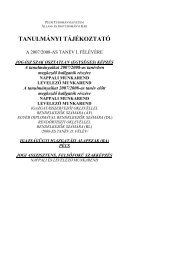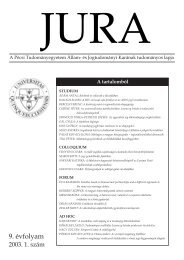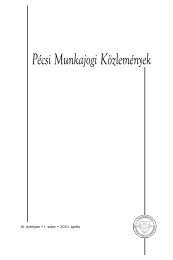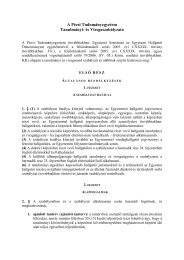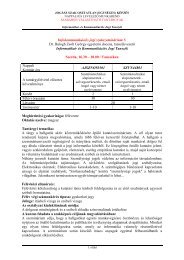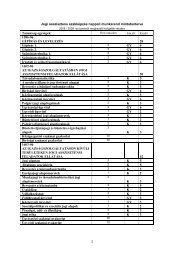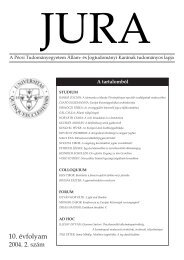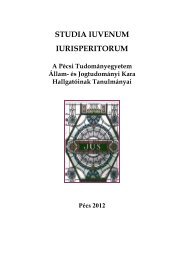2012. évi 2. szám - Jura - Pécsi Tudományegyetem
2012. évi 2. szám - Jura - Pécsi Tudományegyetem
2012. évi 2. szám - Jura - Pécsi Tudományegyetem
- TAGS
- jura
You also want an ePaper? Increase the reach of your titles
YUMPU automatically turns print PDFs into web optimized ePapers that Google loves.
André Ramos Tavares: The case of the borderless use of Constitutional Courts decisions in human rights177André Ramos TavaresProfessor at the Catholic University of São Paulo andDirector of the Brazilian Institute of ConstitutionalResearchThe case of the borderlessuse of Constitutional Courtsdecisions in human rights1. The proposal of this study andcontextualizing the debateThe subject about the use of foreign constitutionalcase law (of the issuing State) by national constitutionalcase law (or generally, of the receiving State)has been the focus of growing attention and concernin recent years in the world. It was with a few recentdecisions handed down by the American SupremeCourt, as in the case of Atkins v. Virginia (the deathpenalty for the mentally retarded), in the cases ofGratz v. Bollinger and Grutter v. Bollinger (affirmativeactions for entry into university) and in the famouscase of Lawrence v. Texas, that the general theme ofthe use of foreign elements began to take shape.But it was the decision from the case of Roperv. Simmons (2005) that most instigated discussion,represented by the alert given by one of its critics,Justice Scalia: ‘The Court should either profess itswillingness to reconsider all these matters in light ofthe views of foreigners, or else it should cease puttingforth foreigners’ views as part of the reasoned basisof its decisions. To invoke alien law when it agreeswith one’s thinking and ignore it otherwise is notreasoned decision making, but sophistry.” This isnot the only cause for concern: in Brazil, an importantdebate began at the Brazilian Supreme FederalCourt on what it means to use foreign elements inconstitutional decisions and the repercussion thereoffor the national system in terms of a real (or veiled)“block upon constitutionality” (Motion No. 3388/RR – the case of the demarcation of the Raposa Serrado Sol indigenous lands).Within this ample discussion 1 is a theme calledstate transposition of judicial decisions (here, my analysiswill be reduced to constitutional decisions), theso-called “transjudicialism”, and also the themeof “cross-constitutionalism”, albeit in its widestsense, which promotes a productive and consciousexchange of constitutional elements between supposedlyself-sufficient states.This is not strictly a novel end-of-decade concept.The fortification of the Judiciary, the creation of a“third giant” 2 , to use the figure proposed by Cappelletti,a phenomenon that has been observed overthe last few decades, has certainly been decisive inelevating the role of judicial decisions between States(treaties and conventions ratified internationally and,later, internalized in general by the parliaments ofeach country) and abandoning the classic proposalthat privileged only normative bodies arising fromthe legislative tiers.All the same, the discussion can be tackled fromcountless perspectives, having been approached fromsignificantly discrete theoretical angles and, traditionally,by using the comparative method, in its widestpossible sense. From the point of view of its jurisdictionaluse, foreign case law has been invoked in manycountries 3 , without great methodological concerns orconcerns of legitimacy as to the use thereof; in mostcases not even the pertinence of its use nor the degreeof connection are the subject of clarification.My objective here is to identify some of the presuppositionsunderlying both this discussion andthe respective constitutional conceptions for acceptingor rejecting such use, although within an ambitrestricted to Constitutional Law 4 . The theme shouldbe duly situated in constitutional theory. For such,one cannot forget the pioneering idea, conceivedby Mauro Cappelletti (1993) and complemented bythe acknowledged Mexican constitutionalist HectorFix-Zamudio (1982), advocating that alongsidethe well-known constitutional jurisdiction of libertiesthere is still space for a „transnational constitutionaljurisdiction”.In this respect, the first observation that deservesto be made is the one where it is impossible for ConstitutionalCourts to treat in identical fashion theuse of foreign constitutional case law 5 and the useof case law arising from the International Courts,such as the European Court of Human Rights andthe International Criminal Court. The different decisionshanded down by these different courts cannotbe conjugated and analyzed with one generic referenceto “foreign case law” lato sensu (or to foreignelements). This also applies to decisions handeddown by supranational courts 6 , intended to evincecommon interests within a community, like the EuropeanCourt of Justice, or even to decisions renderedby these courts in countries that are not within suchsupranational courts’ jurisdictional reach. Furthermore,at issue here is not a phenomenon identical tothe use of foreign constitutional case law in its properand restricted sense 7 .The universal intention contained, in general,in the arguments constructed by international andJURA 2012/<strong>2.</strong>



